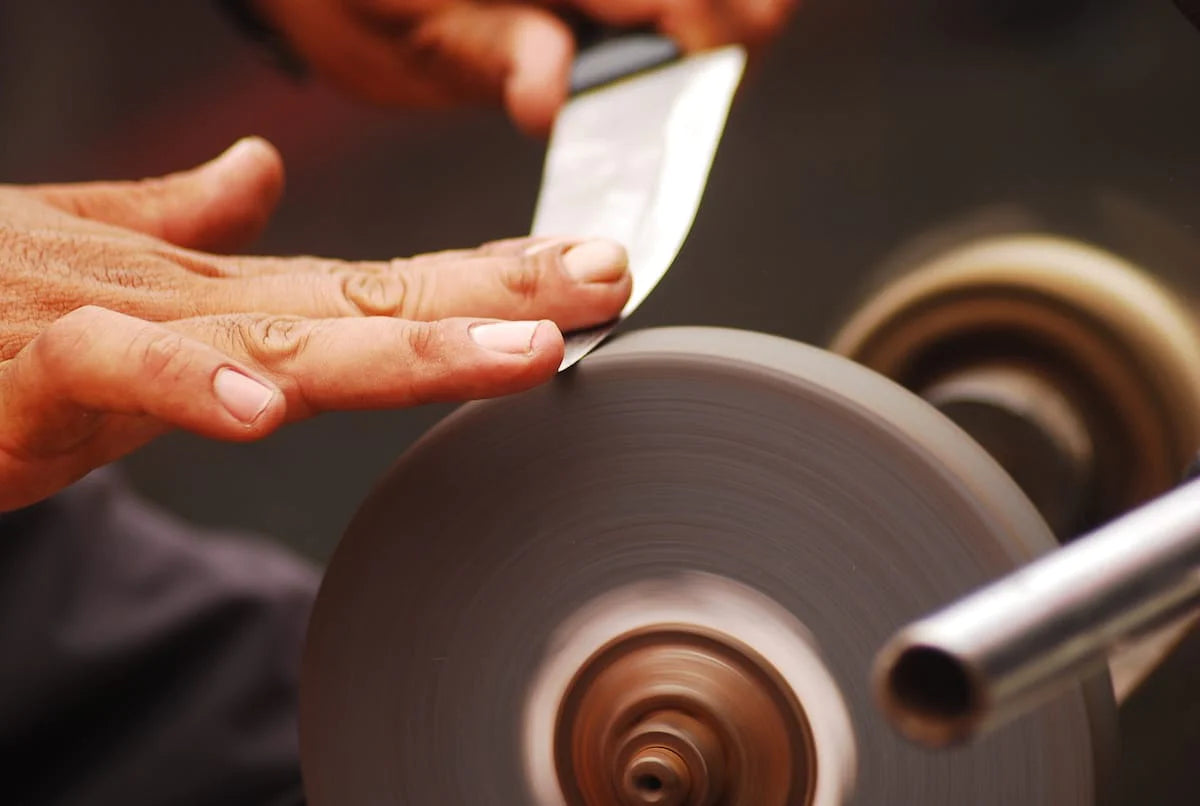on all orders over $100

Do You Really Need a Whetstone? Alternatives to Sharpening Stones
Keeping your tools sharp is essential for any DIY or professional tradesperson. However, when it comes to sharpening, many people assume that sharpening stones, also known as whetstones, are the only option. While whetstones are a versatile and effective sharpening tool, they're not the only option available. So, do you really need a whetstone? In this article, we’ll look at some popular alternatives to sharpening stones and their pros and cons.
Sharpening Stones: The Traditional Method
Whetstones are flat, rectangular blocks of abrasive material, typically made from natural or synthetic materials like ceramic or diamond. They work by removing little bits of metal from the edge of a blade, creating a new, sharp edge.
The advantages of sharpening stones are that they sharpen knives effectively, resulting in a sharp, precise edge. They’re durable, easy to use, transportable, and relatively inexpensive. However, they do require a certain degree of skill to use correctly, and they can be time-consuming. Sharpening stones also require upkeep, and they're not always suitable for all types of blades such as serrated knives.
Electric Sharpeners
Electric sharpeners are becoming more and more popular, offering a fast alternative to traditional sharpening stones. They contain one or more automated diamond abrasive grinding wheels that sharpen edges. These machines are simple to use and require no experience.
Electric sharpeners are quick and easy to use, often taking less than a minute to sharpen a knife. They remove less metal than sharpening stones, which is less wearing on your knives.
However, electric sharpeners can be expensive and may produce an inferior edge compared to other methods. Additionally, they're not always suitable for all types of knives and may not have the finesse necessary for those requiring extremely sharp knives.
Honing Rods
Honing rods are metal rods with a length of between 5-12 inches, made of steel or ceramic. Honing rods are powerful for removing the imperfections from the edge of a knife and can extend the life of an edge in between sharpening. Honing rods do not sharpen a blade but rather re-align its edges.
The advantages of honing rods are that they're quick and simple to use, and they can help maintain a sharp edge for longer periods than sharpening alone. They are also more portable and less expensive than many other similar tools.
Sandpaper
Sandpaper is a viable alternative to a sharpening stone, especially for those on a budget. Sandpaper is affordable, readily available, and can be found in various fineness levels.
Sandpaper is versatile, and its coarseness ranges from fine to coarse offers a range of grit to make your tool as sharp as possible. They're also great because they're disposable and can be thrown away after use.
However, you need a solid surface to secure the sandpaper when using this sharpening method. Additionally, they can be tedious to use, and the process takes longer compared to other tools.
File
A file is a classic alternative for sharpening tools; it has been used for decades for sharpening a range of tools, including knives. They offer precision, and depending on the type, they can be used for sharpening a large range of tools.
The advantages of using a file are that they’re portable, readily available, and, in most cases, affordable. The process is the same as for sharpening with a whetstone or sandpaper, and with the right grit, a file will sharpen your object to a point.
However, files are challenging to use properly and require a bit of experience. It’s also essential to get a file that suits your tool as they are available in varying coarseness.
Ceramic Knives Sharpeners
For those who have ceramic knives, a ceramic sharpener is the most suitable option. These sharpeners are easy to use, and they feature a rod to hone the edge of an existing blade.
Ceramic sharpeners are great for maintaining the edge of your knives between sharpenings. They also offer precision honing, making them an excellent option for those with ceramic knives.
However, ceramic sharpeners can be fragile, making them expensive to replace if they break. They're also not suited to all types of knives.
Conclusion
When it comes to sharpening your blades, there's no one-size-fits-all approach. The right tool for you can depend on various factors, including the type of blade you're sharpening, your budget, and your skill level.
While whetstones offer a traditional, effective method for sharpening blades, there are plenty of alternatives available, such as electric sharpeners, honing rods, sandpaper, files, and ceramic knife sharpeners. Each method has its advantages and disadvantages, but there's no matter which sharpening tool you choose, it’s important to keep a few essential tips in mind. For example, always use the correct pressure when sharpening, and make sure to maintain your knife and its blade often. Additionally, be sure to research and learn how to use any sharpening tool before attempting to sharpen a knife.
Additionally, while different tools may suit different purposes better than others, there are some universal tips that can help you get the best results from any sharpening method. Make sure your surface is level and secure when using manual sharpening tools – this will help minimise mistakes when using them. Furthermore, keep lubrication in mind; a small amount of oil or water can go a long way in keeping your blades free from debris and rust-causing agents.
Finally, be patient! Sharpening by hand takes skill and practice – and honing rods don't provide instant results like some other types of sharpeners – so take it slow while you're getting used to a new technique or tool. With a bit of patience and practice, anyone can become adept at sharpening knives with the right techniques and tools.
